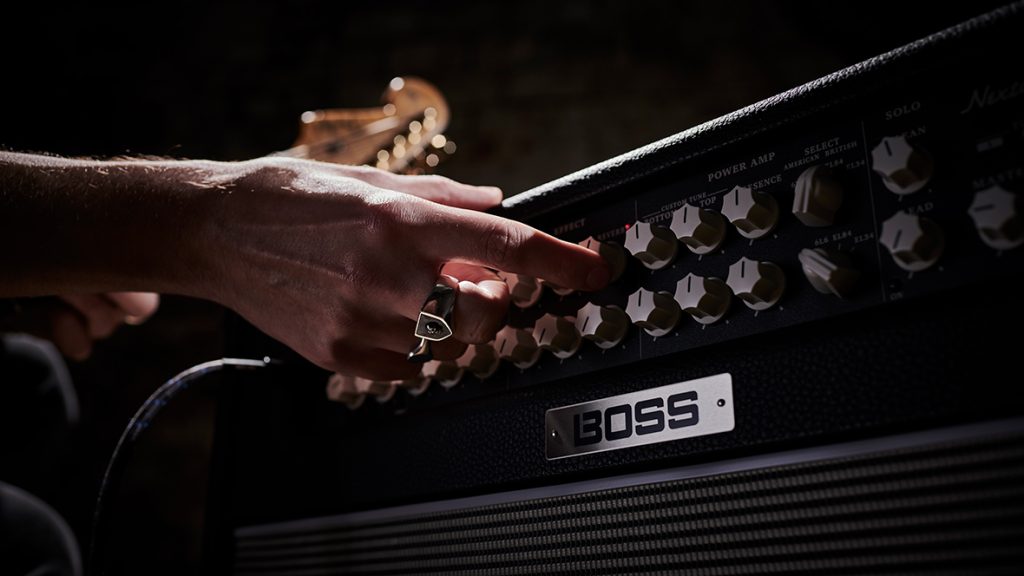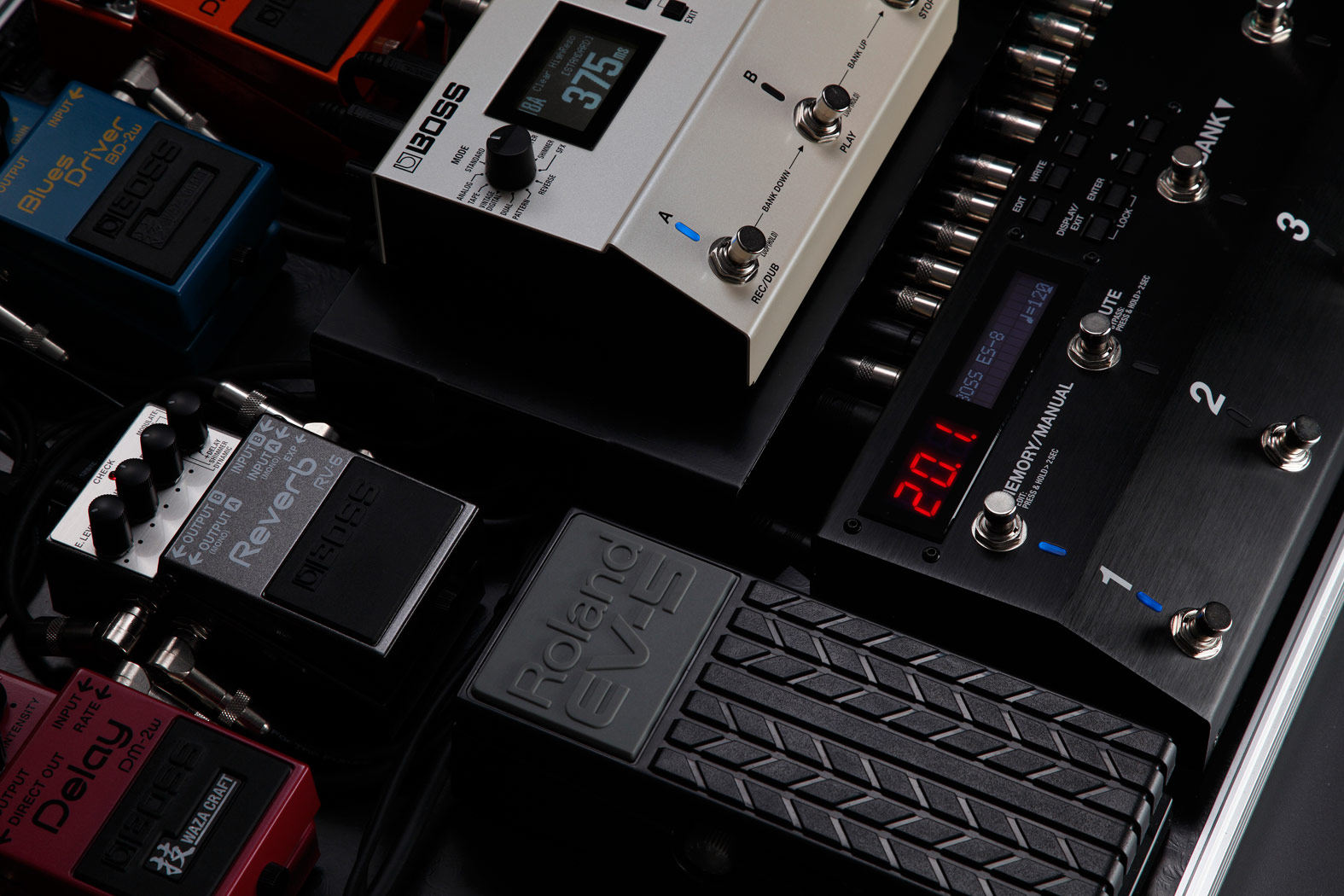Reverb can be the backbone of a guitar tone. It can be a cushion for the guitar to sit comfortably in the mix. The effect can be huge, ethereal, otherworldly, or subtle and delicate, adding a warm finishing touch to every note. Whichever way a guitar player implements a digital reverb pedal in a setup, there are options for expanding sonic capabilities by pairing reverb with another type of effect.
Pairing Reverb
Reverb is unique in terms of how to use it within a pedalboard setup. In almost all cases, it should be the last pedal in the effects chain or separated from the rest of a pedalboard and connected via an amplifier’s effects loop. Either way, every single effect pedal will run into the reverb as the final layer of the total sound.
Reverb is a malleable and essential tool in every guitar player’s arsenal. As a result, it’s important to know what effects it pairs well with to create new and exciting sounds. Fortunately, reverb goes well with just about everything. Still, these are some great examples of the best effects to couple with reverb for classic guitar tones.
PEDAL COMBINATIONS
Delay
Delay is a very close cousin of reverb. Used subtly, it can often perform a very similar task. However, delay can create wonderful, unique, and creative tones when paired with reverb. Tape echo and spring reverb are like two sides of the same coin. Guitarists and producers have combined them on countless recordings to become a blend of effects essential to popular music throughout the decades.
Set the delay pedal for a traditional tape-style slapback echo to make the most of this duo. Do this by setting the time and feedback controls short and low. Then put the reverb pedal to its spring reverb voicing or set the tone control relatively low for a warm reverberation. The tight delay tails feeding into a simple springy reverb are perfect for tones like “Aviation” by The Last Shadow Puppets.
Recommended Pairings
- BOSS RV-6 and RE-202
- BOSS RV-500 and DM-2W
Overdrive or Distortion
Overdrive and distortion are brilliant effects for exciting a guitar tone, adding energy, dynamics, and flair to riffs. They are effects that define and separate genres based on their use. However, the more aggressively they’re used, the more the guitar will jump out of the mix with other instruments. Overdrive and distortion can be dry, harsh, and difficult to balance. That’s where reverb can be a vital pairing with this effects category.
Reverb does the job of taking the edge off that harshness. The tone will retain the best of both effects: the raw aggression and pronounced harmonics of overdrive and the floating ambience of reverb. The overdrive excites the otherwise plain reverb, and the reverb tempers the otherwise dry overdrive—a perfect match. Listen to “Runner” by Ariel Posen for a gorgeous pairing of these effects.
Recommended Pairings
- BOSS RV-6 and DS-1W
- BOSS RV-500 and BD-2W
"Overdrive and distortion can be harsh and difficult to balance. That's where reverb can be a vital pairing."
Volume Pedals
A brilliantly creative way to use reverb is to partner it with a volume pedal, like the FV-30H, to perform volume swells. Players can achieve this by using the volume control on the guitar, as discussed. However, with a volume pedal, it can be a lot easier and more precise.
Set the reverb pedal to a high effects level and time for ethereal volume swells. The effect should be as extreme as possible for this type of sound. Strum a chord with the volume pedal in its heel (off) position and then slowly push it to the toe-down position, bringing up the volume without a strummed guitar’s harsh attack. This method creates a steadily-climbing wall of echo, like a bowed instrument or pad sound on a synthesizer. Volume pedals are ideal for guitarists looking to branch out into more creative tones that are easy to achieve with two pedals.
Recommended Pairings
- BOSS RV-6 and FV-500H
- BOSS RV-500 and EV-30
Tremolo
Looking to create the classic sounds of some of the most loved vintage amplifiers? There is no more quintessential pairing than tremolo and reverb.
Tremolo can provide a simple, effective rhythmic fluctuation in volume. But, it can sometimes be overbearing, especially as many tremolo pedals don’t have a tap tempo function. As a result, it’s unlikely the speed of the tremolo effect is going to be a perfect match to the BPM of the song. Reverb helps to smooth that out. The classic tremolo pulse remains, but with an easy spring reverb-like echo to balance the sound out perfectly. “Vanishing Point” by Alexander Savior is a lovely example of these effects in tandem.
Recommended Pairings
- BOSS RV-6 and TR-2
- BOSS RV-500 and TR-2
"Running an expression pedal ahead of a delay can create a bowed instrument-like swell."
Synth
Synth effects for guitar can open up a whole new world of sonic possibilities. Pedals like the SY-200 have a comprehensive range of sounds—from searing lead synths to pumping arpeggiated bass. Coupled with reverb and used boldly, the sonic possibilities expand further.
Utilizing a reverb pedal’s shimmer function can take a lead synth tone to the next level with a wall of pitch-shifting reverb tails. Just check out Rabea Massad’s demo video pairing the SY-200 with the reverbs on the rest of his pedalboard to make otherworldly soundscapes with his guitar.
Recommended Pairings
- BOSS RV-6 and SY-1
- BOSS RV-500 and SY-200
Amp Setups
Into the Front of an Amp
The easiest, most straightforward way to use reverb is to run it into the front of an amplifier like any other effect. This works perfectly well and is a common approach. However, it will impact the amp gain and the reverb pedal’s reaction.
Traditionally, in the case of a spring reverb-loaded amplifier, the spring mechanism sits after the preamp. This placement means the reverb is unaffected by amp gain or EQ and remains very clean. Running reverb into the front of an amplifier means that with a lot of gain, the effect can get driven and sound muddy.

Generally speaking, it’s best to set the amp up as a clean pedal platform to use a reverb pedal in front of an amplifier. Then place an overdrive or distortion pedal ahead of the reverb in the pedal chain to deal with any driven tones. This placement allows reverb tails to stay clean and precise while retaining the amplifier and drive tones.
"It's best to set the amp up as a clean pedal platform to use a reverb pedal in front of
an amplifier."
In an Effects Loop
A popular alternative method is to run a reverb pedal in an amplifier’s effects loop. By cabling a reverb pedal separately through the effects loop, the reverb will occur after the amplifier’s preamp and gain stage, positioning it in the same place as a spring tank in a combo amp.
Icing the Cake
Reverb is often the icing on the cake in many of its partnerships with other effects. It can easily tame an effect’s harshness and create massive soundscapes and eerie new guitar tones. One of the best things about reverb and other effects is its ability to enhance anything with which it gets paired. Think of reverb as the magical ingredient that makes everything sound just that much better.






